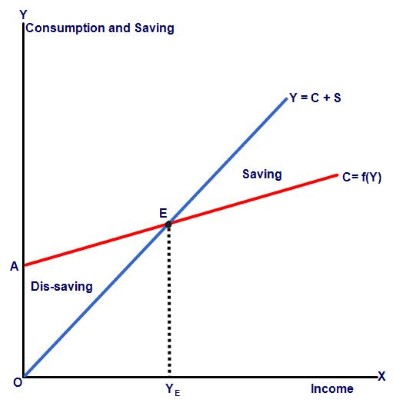The concept of consumption function stems from the basic psychological law of consumption which states that generally, people tend to spend more on consumption when there is an increase in their income level. However, the rise in the spending behavior is not to the same extent as the rise in income because a part of the income is saved as well.
The psychological law of consumption shows the relationship between income and consumption pattern that exists among the household sectors in an economy. As stated by Keynes, “The psychology of the community is such that when the aggregate real income increases, aggregate consumption also increases, but not as much as income.”
The law is based on three interrelated propositions:
- When aggregate income increases, consumption expenditure also increases, but less proportionately. This is because, as a person’s income increases, most of their wants are gradually satisfied. So, less is spent on consumption after a subsequent level of increment in their income.
- It follows that the increment in the level of income is always divided into spending and saving.
- An increase in income thus, leads to an increase in consumption as well as savings. Normally, people would spend more and save more when income increases.
Assumptions
Keynes’ law is limited by the assumptions explained below:
A. Invariability of Psychological and Institutional Factors
The institutional and psychological factors of people remain constant that leads to the stability of propensity to consume. Spending habit, income distribution, inflation, population, etc. remain the same in the long run.
B. Laissez-faire Economic Policy
A free capitalist economy is assumed to exist where there are no government interventions even in case of increase in the level of income. The demand and supply of goods and services are determined by the market.
C. Normal Economic Conditions
Normal conditions are prevalent within the economy. This means that any unusual or extraordinary circumstances such as inflation, war, revolution, etc. have no chances of occurrence.
The law is based on normal human behavior, where, the additional income earned is not just spent on consumption, but a portion of it is saved as well. This means,
ΔY= ΔC + ΔS.
This phenomena can be explained with the help of the following table and diagram:
| Income (Y) | Consumption (C) | Saving (S) |
| 0 | 20 | -20 |
| 50 | 60 | -10 |
| 100 | 100 | 0 |
| 150 | 140 | 10 |
| 200 | 180 | 20 |

The diagram above shows income at OYE where no saving has yet been made. With the gradual increase in income, aggregate saving also increases after OYE level of income. This shows that additional income earned is divided into consumption expenditure and saving.
Implications of the Psychological Law of Consumption
The major implications of the law is it explains the phenomena that marginal propensity to consume is less than unity i.e. MPC < 1.
MPC refers to the additional consumption per unit of additional income, represented as
MPC=ΔC/ΔY
We have, Y= C+ S
Where, Y= Income; C= Consumption; S= Saving
Let increase in income be ΔY and the corresponding increment in consumption and saving be ΔC and ΔS.

Therefore, MPC is less than 1.
The analysis of Keynes’ law shows some major implications of the psychological law of propensity to consume, that include:
A. Highlights the importance of investment in an economy
One of the most important implications of the law is that explains the role of investment when the community of people in an economy spends less than the increment in their salary. As a result of this, a gap exists between aggregate income and aggregate consumption.
In order to remove the widening gap, investment should made in the economy, assuming the consumption function is stable in the short run. Thus, Keynes stresses in the importance of investment for determining the level of income and employment in the economy.
B. Explains the declining phenomena of MPC
When consumption level remains unchanged even with an increment in the income level, the marginal efficiency of capital may decline. This can be avoided if the level of spending is equal to the level of income rise.
Since investment opportunities are fluctuate with the changing rate of interest, the stable consumption function tends to lower the marginal efficiency of capital and investment in the short run.
C. Explanation of the business cycle
MPC being less than unity enables us to understand the fluctuations that occur in the business cycle. When people start saving more than they spend, the economy is at boom, and this leads to fall in the income level. When income falls, and people do not curtail their consumption to the level of decrement in the level of income, the economy turns towards depression.
